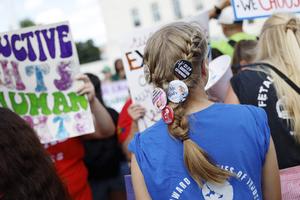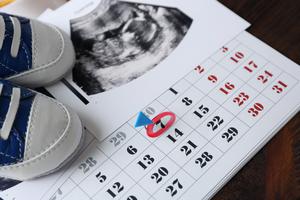Pro-Life Laws Continue to Have an Impact: What the Numbers Are Saying About Births and Abortions Post-Dobbs
Studies tracking births and abortions post-Dobbs indicate that pro-life laws are making a real difference despite a possible increase in abortions nationwide.

WASHINGTON — While pro-life battles continue in the states in the year and a half since Roe v. Wade was overturned, early data indicates that tens of thousands of babies have been born as a result of the strong pro-life laws subsequently barring most abortions in 14 states.
At the same time, one study found an increase in abortions nationwide since the Dobbs decision that overturned Roe in June 2022.
A November study based on preliminary data from the U.S. Centers for Disease Control (CDC) found that “in the first six months of 2023, births rose by an average of 2.3 percent in states enforcing total abortion bans compared to a control group of states where abortion rights remained protected, amounting to approximately 32,000 additional annual births resulting from abortion bans.”
Lifesaving Laws
Michael New, associate scholar at the Charlotte Lozier Institute, the research arm of SBA Pro-Life America, told the Register that this study, commissioned by the IZA Institute of Labor Economics, is just the latest showing that “pro-life laws have resulted in an increase in children being born.”
New noted that while abortions can be “very hard to count” since some women will travel across state lines to obtain them or use chemical abortion pills through the mail, births are easy to count. “When we see good evidence that births are going up, that’s good, solid evidence that more pregnancies are being carried to term because of these pro-life laws,” he said.
He also pointed out that “you didn’t see uniform increases in births across all states; you saw bigger increases in places like Texas and Mississippi” because those states are “far away from out-of-state abortion facilities.”
The study found that effects “vary substantially across ban states, with much larger effects observed in states that are bordered by other ban states and hence have long travel distances to reach facilities that remain open.” In Texas, for example, the study found a 5.1% increase in birth rates; and in Mississippi, there was a 4.4% increase.
Melanie Israel, a policy analyst on life issues at the Heritage Foundation, told the Register that the study reveals a “really encouraging trend” and “underscores that these pro-life laws really do save lives.” She said that behind those percentage increases are “babies who are going to have an opportunity to have a birthday that they maybe wouldn't have otherwise been able to have, and so, going forward, this is not just a one-time victory.”
Israel added that seeing the full impact of pro-life laws will take time, given the period it took for some states to put pro-life limits in place following the Dobbs decision. “We do have those preliminary signs that many, many lives are being saved in these pro-life states, and that’s really encouraging,” she said.
There is additional data showing the impact of strong pro-life laws even prior to the Dobbs decision. A June 2023 study on the effect of the Texas heartbeat law barring abortion at around six weeks’ gestation found that the policy, which went into effect in September 2021, was “associated with 9,799 additional births in Texas between April and December 2022.”
Possible Abortion Increase
New also addressed a report that abortions have increased in the U.S. since the Dobbs decision, based on a study by the pro-abortion nonprofit Society of Family Planning, which found that “compared to the average monthly number of abortions observed in the pre-Dobbs period of April and May 2022, there were 2,200 cumulative more abortions during the 12 months July 2022 to June 2023.”
He noted some concerns with the report’s methodology, including that the study is only looking “at about two months’ worth of pre-Dobbs data,” when they should be looking at “a year’s worth of pre-Dobbs data versus a year of post-Dobbs data.”
He did acknowledge that “it is possible that we could see lives being saved in pro-life states, but abortion increases elsewhere.” He pointed to the fact that more than half of abortions are chemical abortions through pills and that trend is only likely to increase as blue states continue to expand access to abortion pills.
Regarding the increase in abortions in the Society for Family Planning study, Israel also believed the increased availability of abortion pills was part of the problem. She noted a shift in the 2021 abortion CDC numbers, released in November, with “more abortions happening earlier and earlier, to the point that even a heartbeat law is not necessarily going to be capturing a huge portion of these abortions.”
According to the 2021 CDC numbers, 44.8% of abortions are now taking place at or before six weeks’ gestation and medication abortion accounted for 70.6% of those abortions. The CDC also found a 5% increase in the overall number of abortions the year before the Dobbs decision.
More Babies
The IZA study showing an increase in births in states with strong pro-life laws met with a negative response from some, including Alison Gemmill, an assistant professor at the Johns Hopkins Bloomberg School of Public Health, who told CNN that the increase in births was “an assault on reproductive autonomy.”
Israel called that reaction “bizarre” because “we’re talking about babies who have been born. They’re here with us today,” adding that she couldn’t imagine “somebody staring at a little baby and thinking of that precious little baby as being an assault on somebody else.”
The study itself linked the findings to negative consequences, stating that “if the past foretells our present, the Dobbs decision will result in increases in unintended births and exacerbate economic inequality.” The authors concluded, “if future research using finalized data and additional policy variation reveals continued substantial effects on births, then we expect long-lasting and profound effects on the lives of affected pregnant people and their families, including effects on educational investment, employment, earnings, and financial security.”
Prominent pro-life women have spoken out against claims that women need abortion for economic success in the past. In an amicus brief in the Dobbs case, 240 women scholars, professionals and various pro-life organizations questioned the narrative in the Supreme Court’s 1992 Planned Parenthood v. Casey decision, asserting that women rely on abortion in order to advance socially and economically.
The brief’s authors pointed out that while abortion was on the decline for decades, women in the workforce with a college degree were on the rise.
“From 1990 to 2016, abortion rates declined 46% from 345 to 186, and abortion ratios fell 52% from 24 to 11.6,” they wrote regarding “recent decades’ precipitous declines in abortion rates (abortions per 1,000 women of childbearing age) and ratios (abortions per pregnancies, excluding miscarriages and stillbirths).”
“During this same period, however, the percentage of women in the workforce with a college degree or more rose from 24.5% to 41.6%. This is a 70% increase. Women also continued to earn an increasing percentage of men’s income, rising from 70.9 to 81.9 or a 15.5% increase.”















